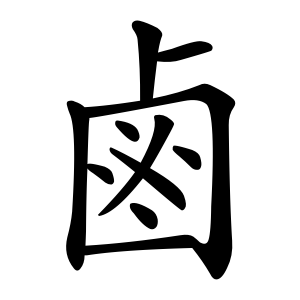鹵
- salt;
鹵 represents inland salt fields used for salt production in the western regions. However, these salt fields are not like the coastal salt pans most people typically imagine. Since salt pans as we know them can't exist inland, the “salt fields” referred to here are actually saline-alkaline soils—land so saturated with salt that crops can't grow there.
Etymology
According to the Shuowen Jiezi (an ancient Chinese dictionary), there was a region named Lǔ County (鹵縣) in a place called Anding (now Gansu Province), which was known for salt production. Over time, the meaning of the character expanded to also refer to natural salt (i.e., not man-made). By contrast, salt fields in eastern coastal areas were referred to using the character 斥.
There are several theories about the origin of the character:
1. Shuowen Jiezi explains that it is derived from the character 西 (west), because salt fields existed in the west.
2. Some say the form of 鹵 in oracle bone script and ancient script resembles four divided spaces with dots inside, possibly modeling the layout of a salt field.
3. Others interpret it as a basket filled with salt crystals or rock salt fragments.
Visually, the character is often likened to the shape of a modern shampoo bottle.
Usage in Korean
As a radical, it conveys meanings related to salt.
Examples of characters with this radical include:
鹽 (염, salt)
鹹 (함, salty)
Additional notes
In modern Chinese, 鹵 is used to refer to halogen elements, as “halogen” literally means “salt-producing.” So the character remains fittingly used in scientific contexts.
Interestingly, 鹵 is also historically interchangeable with the character 擄 (to plunder), giving rise to meanings related to pillaging or seizing. This is why expressions like 鹵獲 (captured loot or spoils of war) exist.
- 卜田戈戈 (YWII)
- ⿴ 占 𠂭
- ⿱ 卜 𱕻
